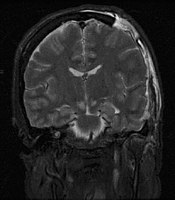
Photo from wikipedia
Importance In patients with space-occupying hemispheric infarction, surgical decompression reduces the risk of death and increases the chance of a favorable outcome. Uncertainties, however, still remain about the benefit of… Click to show full abstract
Importance In patients with space-occupying hemispheric infarction, surgical decompression reduces the risk of death and increases the chance of a favorable outcome. Uncertainties, however, still remain about the benefit of this treatment for specific patient groups. Objective To assess whether surgical decompression for space-occupying hemispheric infarction is associated with a reduced risk of death and an increased chance of favorable outcomes, as well as whether this association is modified by patient characteristics. Data Sources MEDLINE, Embase, the Cochrane Central Register of Controlled Trials, and the Stroke Trials Registry were searched from database inception to October 9, 2019, for English-language articles that reported on the results of randomized clinical trials of surgical decompression vs conservative treatment in patients with space-occupying hemispheric infarction. Study Selection Published and unpublished randomized clinical trials comparing surgical decompression with medical treatment alone were selected. Data Extraction and Synthesis Patient-level data were extracted from the trial databases according to a predefined protocol and statistical analysis plan. The Preferred Reporting Items for Systematic Reviews and Meta-analyses (PRISMA) reporting guideline and the Cochrane Collaboration's tool for assessing risk of bias were used. One-stage, mixed-effect logistic regression modeling was used for all analyses. Main Outcomes and Measures The primary outcome was a favorable outcome (modified Rankin Scale [mRS] score ≤3) at 1 year after stroke. Secondary outcomes included death, reasonable (mRS score ≤4) and excellent (mRS score ≤2) outcomes at 6 months and 1 year, and an ordinal shift analysis across all levels of the mRS. Variables for subgroup analyses were age, sex, presence of aphasia, stroke severity, time to randomization, and involved vascular territories. Results Data from 488 patients from 7 trials from 6 countries were available for analysis. The risk of bias was considered low to moderate for 6 studies. Surgical decompression was associated with a decreased chance of death (adjusted odds ratio, 0.16; 95% CI, 0.10-0.24) and increased chance of a favorable outcome (adjusted odds ratio, 2.95; 95% CI, 1.55-5.60), without evidence of heterogeneity of treatment effect across any of the prespecified subgroups. Too few patients were treated later than 48 hours after stroke onset to allow reliable conclusions in this subgroup, and the reported proportions of elderly patients reaching a favorable outcome differed considerably among studies. Conclusions and Relevance The results suggest that the benefit of surgical decompression for space-occupying hemispheric infarction is consistent across a wide range of patients. The benefit of surgery after day 2 and in elderly patients remains uncertain.
Journal Title: JAMA neurology
Year Published: 2020
Link to full text (if available)
Share on Social Media: Sign Up to like & get
recommendations!